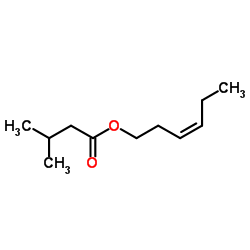(3Z)-3-Hexen-1-yl 3-methylbutanoate

(3Z)-3-Hexen-1-yl 3-methylbutanoate structure
|
Common Name | (3Z)-3-Hexen-1-yl 3-methylbutanoate | ||
|---|---|---|---|---|
| CAS Number | 35154-45-1 | Molecular Weight | 184.275 | |
| Density | 0.9±0.1 g/cm3 | Boiling Point | 231.8±19.0 °C at 760 mmHg | |
| Molecular Formula | C11H20O2 | Melting Point | N/A | |
| MSDS | Chinese USA | Flash Point | 79.5±19.9 °C | |
| Symbol |

GHS02 |
Signal Word | Warning | |
| Name | (Z)-3-hexen-1-yl 3-methylbutanoate |
|---|---|
| Synonym | More Synonyms |
| Density | 0.9±0.1 g/cm3 |
|---|---|
| Boiling Point | 231.8±19.0 °C at 760 mmHg |
| Molecular Formula | C11H20O2 |
| Molecular Weight | 184.275 |
| Flash Point | 79.5±19.9 °C |
| Exact Mass | 184.146332 |
| PSA | 26.30000 |
| LogP | 3.83 |
| Vapour Pressure | 0.1±0.5 mmHg at 25°C |
| Index of Refraction | 1.441 |
CHEMICAL IDENTIFICATION
HEALTH HAZARD DATAACUTE TOXICITY DATA
|
| Symbol |

GHS02 |
|---|---|
| Signal Word | Warning |
| Hazard Statements | H226 |
| Hazard Codes | N |
| Risk Phrases | R36/37/38 |
| Safety Phrases | S26-S36/37/39 |
| RIDADR | UN 3272 3/PG 3 |
| WGK Germany | 2 |
| RTECS | NY1505000 |
| HS Code | 2915900090 |
| HS Code | 2915900090 |
|---|---|
| Summary | 2915900090 other saturated acyclic monocarboxylic acids and their anhydrides, halides, peroxides and peroxyacids; their halogenated, sulphonated, nitrated or nitrosated derivatives VAT:17.0% Tax rebate rate:9.0% Supervision conditions:AB(certificate of inspection for goods inward,certificate of inspection for goods outward) MFN tariff:5.5% General tariff:30.0% |
|
Off-season biogenic volatile organic compound emissions from heath mesocosms: responses to vegetation cutting.
Front. Microbiol. 4 , 224, (2013) Biogenic volatile organic compounds (BVOCs) affect both atmospheric processes and ecological interactions. Our primary aim was to differentiate between BVOC emissions from above- and belowground plant... |
|
|
Defense-inducing volatiles: in search of the active motif.
J. Chem. Ecol. 34 , 601-4, (2008) Herbivore-induced volatile organic compounds (VOCs) are widely appreciated as an indirect defense mechanism since carnivorous arthropods use VOCs as cues for host localization and then attack herbivor... |
| (3Z)-Hex-3-en-1-yl 3-methylbutanoate |
| EINECS 252-404-3 |
| cis-3-Hexenylisovalerat |
| Isovaleric Acid cis-3-Hexenyl Ester |
| cis-3-Hexene |
| cis-3-Hexene,pure |
| MFCD00036533 |
| cis-3-Hexenyl 3-methylbutanoate |
| (3Z)-3-Hexen-1-yl 3-methylbutanoate |
| Butanoic acid, 3-methyl-, (3Z)-3-hexen-1-yl ester |
| 3-cis-hexene |
| cis-3-hexene-1-ol isovalerate |
| cis-3-Hexenyl Isovalerate |
| cis-hex-3-ene |

